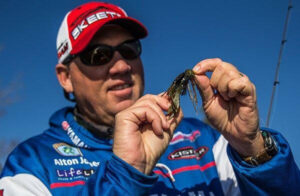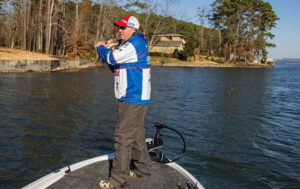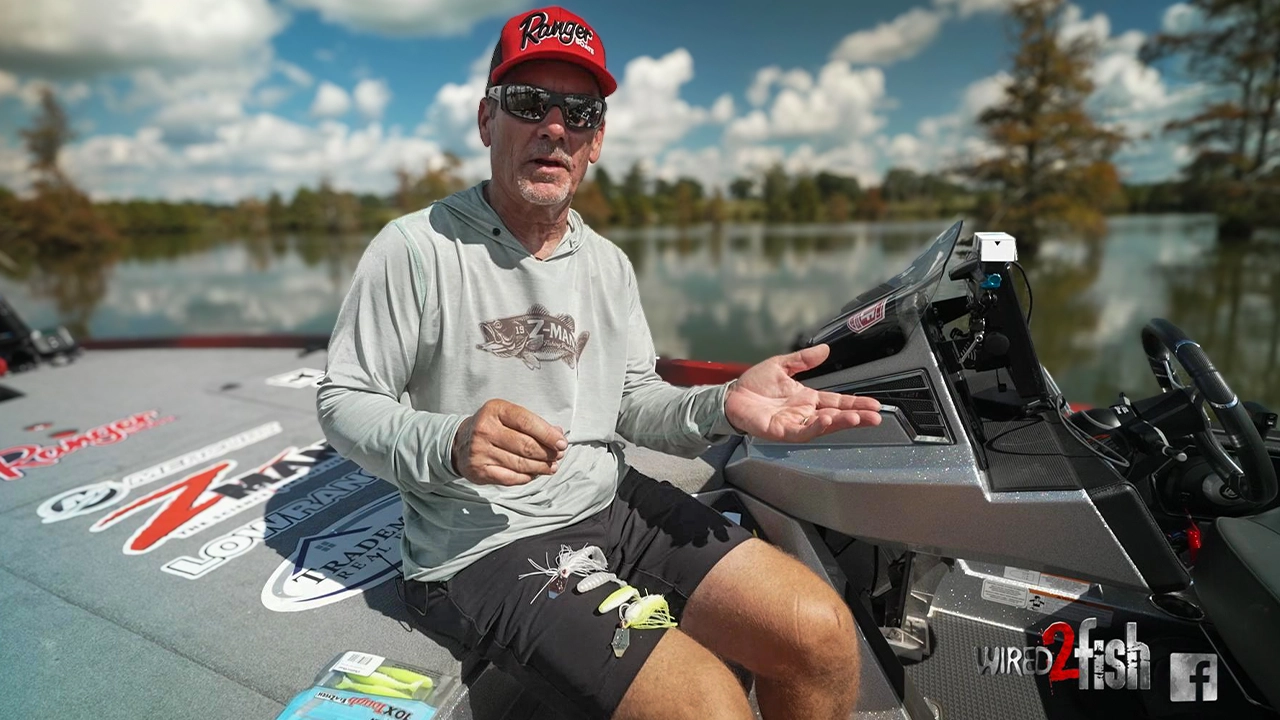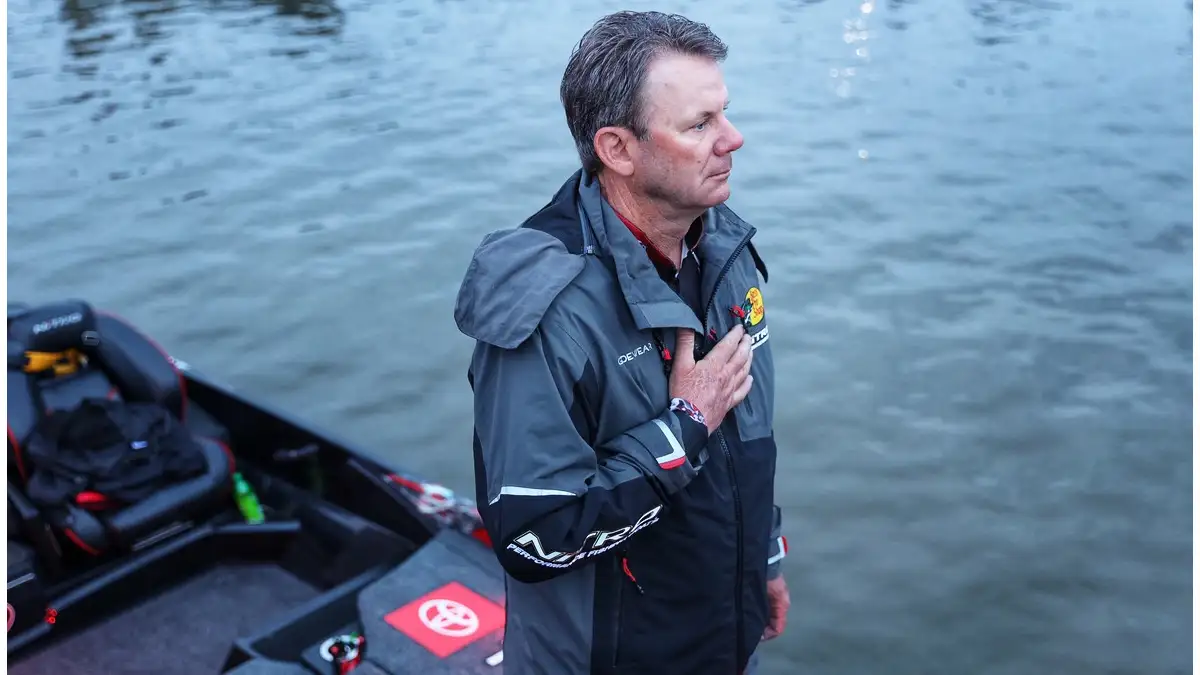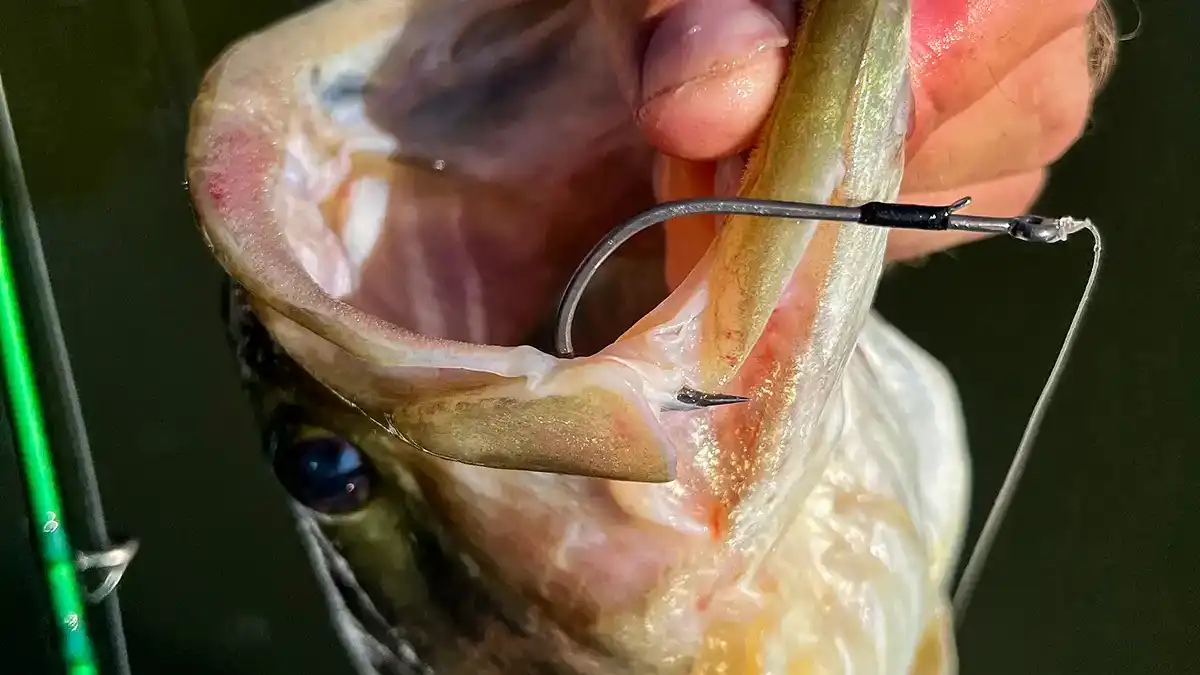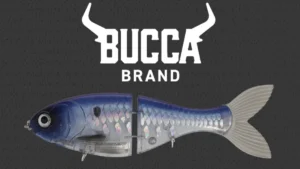The current frosty conditions may not be conducive for great bass fishing, but football jigs offer a ray of hope in an otherwise tough fishing season. When water temperatures plummet and bass activity screeches to a halt, these deep water jigs can cure even the toughest case of lockjaw.
Elite Series pro and 2008 Bassmaster Classic champion Alton Jones places a lot of trust in football jigs throughout the late winter months. Not only did this technique play an instrumental role in his Classic win, but he also considers it one of the most essential tools in his wintertime bass fishing arsenal.
His in-depth tips will help you make the most out of the remaining weeks—or months—of winter.
The difference between football jigs and traditional jigs
The secret has been out for years—jigs catch big bass. While the difference between football jigs and traditional jigs may seem diminutive to some, a football jig’s unique head shape is the difference maker in cold water.
“Think about a football rolling around on a patch of grass,” Jones said. “There’s no possible way to predict where it’s going to go. The same thing happens with a football jig. As you bump it along the bottom, the small points on each end of the head catch on each piece of cover it hits, causing it to pivot away from cover and create a lot of commotion. A traditional jig, on the other hand, is just like a soccer ball—you know where it’s going to go when you roll it and it doesn’t leave much to the imagination.”
Football jig advantages
The football jig’s unique head shape creates enticing commotion in deep water.
If you spend enough time on the water, there’s a decent chance of running across small populations of shallow bass. The majority of bass, however, are likely to spend most of their time in deep water. This biological preference makes it imperative to utilize a presentation that gets down to the bass quickly and stays in front of them. A football jig does just that.
Football jigs are much more user-friendly around hard cover such as rocks, sand and gravel. It’s not a favorable option for vegetation as its head will collect large amounts of weeds and grass.
Heavier—“Football jigs are usually much heavier than traditional jig styles,” Jones said. “This added weight allows you to maintain bottom contact throughout your entire retrieve, therefore increasing your time in the most productive strike zone.
Covers water—“Football jigs are meant to cover large amounts of water in a short amount of time,” Jones said. “I’m going to use them in areas void of excessive cover in which the bottom composition itself acts as cover for the bass. You can make very long casts with it, it falls quickly and you can retrieve it rapidly, effectively combing an entire area in search of aggressive bass.”
Vibration transmission—“The larger surface area of a football jig’s head transmits vibration to your rod tip very well,” Jones said. “So much of winter fishing revolves around the detection of hard bottom compositions, which makes it important to feel what’s going on down there. This technique will alert you to very subtle differences in composition which, in turn, can result in giant bass.”
Broad timespan—“In my experience, I’ve never seen the conditions too cold for a football jig,” Jones said. “As long as the lake isn’t iced-over, it will catch bass. With that being said, I’ve also caught a lot of fish in 90-degree water with one as well, so it’s extremely versatile. It’s one of those baits that will continue to produce in a plethora of conditions.”
Where to fish a football jig
As mentioned earlier, Jones focuses his efforts toward the deeper depths when fishing with a football jig. By concentrating on areas close to deeper water, he’s able to make high-percentage casts and develop a pattern proficiently.
- Ledges—“Whenever I’m fishing ledges, whether they’re located in a river or creek, I’m constantly looking for stretches in which the bottom is harder than surrounding areas,” Jones said. “You may have a five-mile long river ledge with small mussel beds scattered throughout and sometimes your graph won’t pick them up. I’ll follow the channel contours and make long casts in front of the boat. Whenever I feel it ticking across a hard bottom, I make a waypoint because that’s when you’ll get bit.”
- Rock points—“Rock points are a little more visible and easier to locate on most fisheries,” Jones said. “I’ll sit my boat in deep water and cast to the shallow side of the point and work it into deeper water. If you try to bring it deep-to-shallow, you’ll hang up a lot. The ideal rock point will drop into deeper water and be located very near the edge of a creek or river channel. Almost any tournament this time of year will be won near deep channels.”
- Bars—“I’m going to fish these areas just like I would a ledge,” Jones said. “These bars will be high spots, or ridges, between the major channel and the shore. They’ll have little ditches around them and are very often overlooked by other anglers. Some fisheries may have four or five bars running parallel to the river channel. Similar to ledge fishing, I’m going to constantly search for hard bottom with my football jig.”
- Timber transitions—“On some lakes, coldwater bass will position on the inside edge standing timber this time of year, like they did when I won the Classic,” Jones said. “Wherever you can find the transition from cover to no cover will be an absolute hotspot for a football jig. Make your casts parallel to the transition line and you can cover a lot of water to uncover the sweet spot.”
- Roadbeds—“Manmade roadbeds are similar to timber transitions,” Jones said. “The road itself will be void of cover, but there will often be trees stacked on either side of it. I like to put my boat directly on top of the bare spot and cast my football jig parallel on both sides of the roadbed.”
The cast, retrieve and hookset
Fishing with a football jig is very different when compared to more traditional jig styles. You won’t see Jones making short casts, slow retrieves or enormous hooksets. He bases his style of fishing around efficiency.
- Cast—“I always try to make the longest cast I possibly can with a football jig,” Jones said. “It’s hard to make yourself do it if you’re used to traditional fishing styles, but these long casts are instrumental to covering water and locating groups of aggressive bass.”
- Retrieve—“After I let my football jig sink all the way to the bottom, I want to reel it—not drag it—as fast as I can while keeping contact with the bottom,” Jones said. “I know a lot of folks like to drag jigs, but you’ll be amazed how much a fast, steady retrieve will increase your success. It makes your jig look just like a crawfish fumbling around the bottom, so let its head shape do the work for you.”
- Hookset—“More times than not, a bass is going to knock your football jig incredibly hard,” Jones said. “Remember, you’re fishing it in areas void of heavy cover, so there’s no going to be much down there to fool you. My hookset is just like a Carolina rig hookset. I point my rod at the fish and start reeling until the line is tight. When I retrieve all the slack line, I sweep my rod tip to the side and stick ‘em. Snap hooksets are dangerous—you’re creating a lot of speed with the lure and the football jig’s bulky head will force the bass’ jaws open, pulling your jig out of its mouth.”
Weight and trailer selection
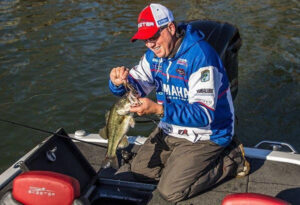
There certainly some bottom-oriented bass fishing techniques that require precise weight selection, but Jones doesn’t make it too complicated when he’s fishing with a football jig. The most important aspect is bottom contact.
- Weight size—“My first choice is a 3/4-ounce Booyah Pigskin Jig,” Jones said. “I like to use a heavier football jig for one reason—weight matters when they’re eating it on the fall. You’re going to get your football jig bites on the bottom, so my main concern is being able to keep bottom contact throughout my retrieve. When I’m fishing deeper than 30 feet, I’ll typically upsize to a 1-ounce Pigskin Jig.”
- Trailer selection—“After Brent Chapman showed me how effective it is to use big trailers on football jigs, I became an instant believer,” Jones said. “My absolute favorite trailer is a YUM F2 Wooly Hawgtail—it’s almost the only one I use. I don’t bite it off or shorten it at all. I like to use a color that matches my jig, so I stick with green pumpkin, watermelon seed and black blue”
No bass, no problem
Professional anglers invest countless hours learning to quickly eliminate dead water. While many techniques require the presence of bass or bait on their electronics in order to warrant a cast, fishing with football jigs is very different.
“Throughout the winter, both bass and bait can get so close to the bottom that they become invisible on your electronics,” Jones said. “This makes it unnecessary for me to see activity on my units before casting my football jig. If I see a good-looking spot with some type of change in topography, I’ll always make a few casts. This is one of the few baits that can catch those invisible bass consistently.”
It’s tough to get motivated to endure the elements this time of year, but football jigs can save a tough day of winter bass fishing—they’ve been doing it for years. The next time you have trouble getting a bite in nasty conditions, consider a football jig. If you can understand how it works, where it works best and how to fish it, you have a great chance of catching giant bass.
What’s the biggest bass you’ve ever caught on a football jig? In what depth of water did you catch it? Let us know in the comments!



